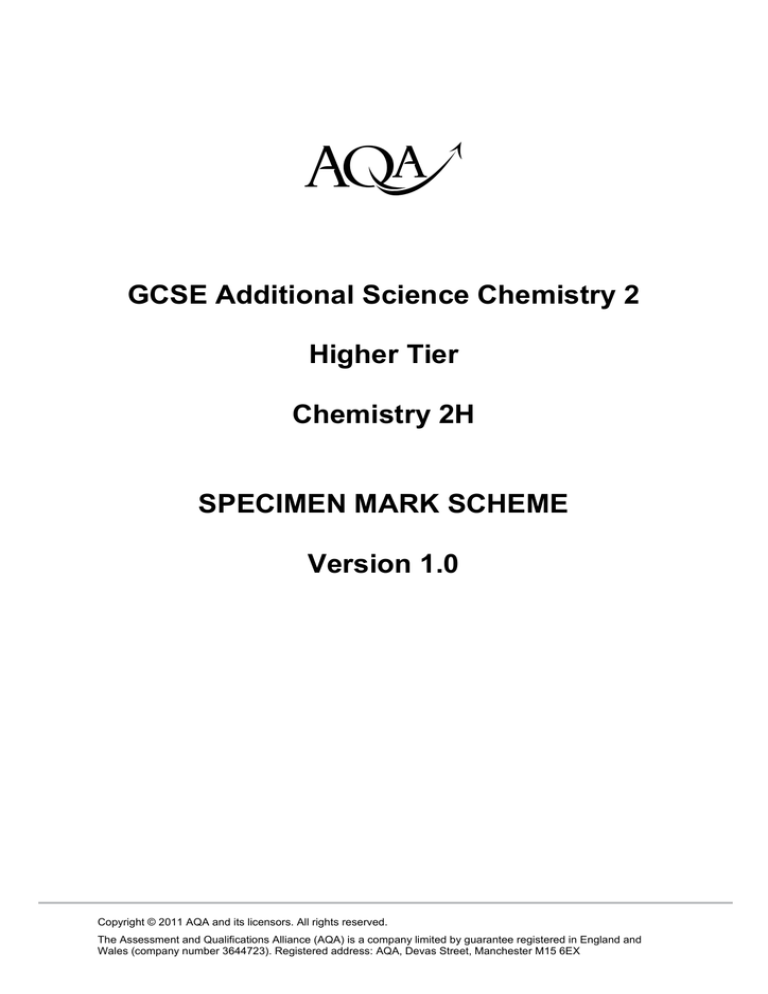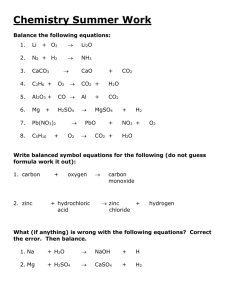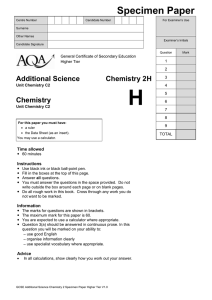
hij
GCSE Additional Science Chemistry 2
Higher Tier
Chemistry 2H
SPECIMEN MARK SCHEME
Version 1.0
Copyright © 2011 AQA and its licensors. All rights reserved.
The Assessment and Qualifications Alliance (AQA) is a company limited by guarantee registered in England and
Wales (company number 3644723). Registered address: AQA, Devas Street, Manchester M15 6EX
Quality of Written Communication and levels marking
In Question 3(a) candidates are required to produce extended written material in
English, and will be assessed on the quality of their written communication as well as
the standard of the scientific response.
Candidates will be required to:
• use good English
• organise information clearly
• use specialist vocabulary where appropriate.
The following general criteria should be used to assign marks to a level:
Level 1: basic
• Knowledge of basic information
• Simple understanding
• The answer is poorly organised, with almost no specialist terms and their use
demonstrating a general lack of understanding of their meaning, little or no
detail
• The spelling, punctuation and grammar are very weak.
Level 2: clear
• Knowledge of accurate information
• Clear understanding
• The answer has some structure and organisation, use of specialist terms has
been attempted but not always accurately, some detail is given
• There is reasonable accuracy in spelling, punctuation and grammar, although
there may still be some errors.
Level 3: detailed
• Knowledge of accurate information appropriately contextualised
• Detailed understanding, supported by relevant evidence and examples
• Answer is coherent and in an organised, logical sequence, containing a wide
range of appropriate or relevant specialist terms used accurately.
• The answer shows almost faultless spelling, punctuation and grammar.
In order to attain a mark within a certain level, both the science and the QWC must
be of a standard appropriate to that level.
GCSE Additional Science Chemistry 2 Specimen Mark Scheme Higher Tier V1.0
COMPONENT NUMBER: CH2HP
COMPONENT NAME: GCSE Additional Science Chemistry 2H
STATUS: Specimen V1.0
question
answers
extra information
mark
1(a)(i)
curve missing anomalous point
1
1(a)(ii)
answer in the range of 100.35 to
100.5
1
1(a)(iii)
reaction goes quickly at first
1
1(b)
reaction stops
accept reaction slows down
1
because carbon dioxide is
produced
accept gas is produced
1
carbon dioxide / gas escapes,
therefore the mass of the flask
and contents decreases
1
1(c)(i)
balance B
1
1(c)(ii)
because during the experiment a
gas / carbon dioxide escapes
from the flask
1
therefore the balance needs a
high resolution to measure the
small changes in the mass
1
the (marble) powder has a larger
surface area than the (marble)
chips
1
therefore there can be more
collisions with the acid particles
(within the same amount of time)
1
1(d)
Total
GCSE Additional Science Chemistry 2 Specimen Mark Scheme Higher Tier V1.0
11
COMPONENT NUMBER: CH2HP
COMPONENT NAME: GCSE Additional Science Chemistry 2H
STATUS: Specimen V1.0
question
answers
extra information
mark
2(a)(i)
column
1
2(a)(ii)
mass spectrometer
1
2(b)(i)
165
2
if answer is not correct then
evidence of correct working gains
one mark
eg (10x12) + 15 + 14 + 16
2(b)(ii)
10.37 (%)
accept 10 / 10.4 / 10.37.........
2
if answer is not correct then
evidence of correct working gains
one mark
eg minimum evidence would be
14 / 135
2(c)
2(d)
any two from:
•
faster
•
more accurate
•
detects smaller amounts
to avoid bias
to improve reliability
2
accept to check / compare the
result
Total
GCSE Additional Science Chemistry 2 Specimen Mark Scheme Higher Tier V1.0
1
1
10
COMPONENT NUMBER: CH2HP
COMPONENT NAME: GCSE Additional Science Chemistry 2H
STATUS: Specimen V1.0
3(a)
Marks awarded for this answer will be determined by the Quality of Written Communication
(QWC) as well as the standard of the scientific response. Examiners should also refer to
the information on page 2.
0 marks
No relevant
content.
Level 1 (1-2 marks)
There is a brief
description of the
electrolysis of
aluminium oxide.
Level 2 (3-4 marks)
There is some
description of the
electrolysis of
aluminium oxide.
Level 3 (5-6 marks)
There is a clear,
balanced and detailed
description of the
electrolysis of
aluminium oxide.
examples of the chemistry points made in the response
• aluminium oxide is melted / made liquid
• aluminium ions are attracted to the negative electrode
• at the negative electrode aluminium is formed or aluminium ions gain electrons
• oxide ions are attracted to the positive electrode
• oxygen is formed at the positive electrode or oxide ions lose electrons
• the oxygen reacts with carbon to make carbon dioxide or
carbon dioxide formed at positive electrode
3(b)
there are delocalised electrons /
free electrons / electrons which
move within the aluminium /
metallic structure
if the candidates use the terms
covalent / ionic / molecules /
intermolecular incorrectly in the
answer this will limit the mark to a
maximum of 1
therefore these electrons are able
to carry the current / charge
Total
GCSE Additional Science Chemistry 2 Specimen Mark Scheme Higher Tier V1.0
1
1
8
COMPONENT NUMBER: CH2HP
COMPONENT NAME: GCSE Additional Science Chemistry 2H
STATUS: Specimen V1.0
question
answers
4(a)
3
4(b)
sodium hydroxide / potassium
hydroxide / alkali / a hydroxide
4(c)
the chromium ions form a
precipitate which can be removed
by filtration
extra information
accept correct multiples
mark
1
1
accept the chromium ions form a
solid which can be removed by
filtration
Total
GCSE Additional Science Chemistry 2 Specimen Mark Scheme Higher Tier V1.0
1
3
COMPONENT NUMBER: CH2HP
COMPONENT NAME: GCSE Additional Science Chemistry 2H
STATUS: Specimen V1.0
question
answers
5(a)
one nitrogen atom joined to three
hydrogen atoms
1
correct pairs of electron
1
because ammonia is made of
small molecules / simple
molecules / simple molecular
structures
1
and so there are weak forces
between the molecules or and so
the intermolecular forces are
weak
1
5(b)
extra information
mark
incomplete answers that link only
size of molecule or strength of
intermolecular forces with boiling
point only gain 1 mark
5(c)(i)
hydroxide
1
5(c)(ii)
nitric
1
because this is an endothermic
reaction
1
that takes in energy from the
surroundings as the ammonium
nitrate dissolves
1
5(d)
Total
GCSE Additional Science Chemistry 2 Specimen Mark Scheme Higher Tier V1.0
8
COMPONENT NUMBER: CH2HP
COMPONENT NAME: GCSE Additional Science Chemistry 2H
STATUS: Specimen V1.0
question
6
answers
in pure copper the atoms are
arranged in layers
extra information
accept a correct diagram
therefore copper is soft because
copper atoms can slide over each
other
in bronze the tin atoms disrupt /
distort the structure
mark
1
1
accept a correct diagram
therefore bronze is harder than
copper because the metal atoms
cannot slide over each other
1
1
Total
4
COMPONENT NUMBER: CH2HP
COMPONENT NAME: GCSE Additional Science Chemistry 2H
STATUS: Specimen V1.0
question
7
answers
used plastic bottles are heated
extra information
accept used plastic bottles are
melted
mark
1
then moulded / extruded into a
new shape / object
1
because the polymer chains /
molecules in the plastic have
weak intermolecular forces
1
that allow these polymer chains /
molecules to become mobile
when heated
1
Total
GCSE Additional Science Chemistry 2 Specimen Mark Scheme Higher Tier V1.0
4
COMPONENT NUMBER: CH2HP
COMPONENT NAME: GCSE Additional Science Chemistry 2H
STATUS: Specimen V1.0
question
answers
8(a)
the sodium atom loses / transfers
an / one electron
1
the chlorine atom gain(s) this / an
/ one electron
1
involves electrons in the outer
energy levels / shells of both the
sodium atom and the chlorine
atom
1
sodium chloride has a giant
structure / lattice of oppositely
charged ions / positive and
negative ions
1
the electrostatic forces of
attraction / bonds between ions
are strong
1
therefore sodium chloride has a
high melting point because a
large amount of energy is needed
to make the ions mobile
1
8(b)
Total
GCSE Additional Science Chemistry 2 Specimen Mark Scheme Higher Tier V1.0
extra information
mark
6
COMPONENT NUMBER: CH2HP
COMPONENT NAME: GCSE Additional Science Chemistry 2H
STATUS: Specimen V1.0
question
9(a)
answers
130.4
extra information
accept 130 to 130.43478………
mark
2
correct answer gains two marks
with or without working
an answer of 131 would gain one
mark.
if answer is not correct then:
moles of salicylic acid = 0.7 …….
(1 mark)
or
mass of aspirin = moles of
salicylic acid x 180 (1 mark)
or
100 x (180/138) (1 mark)
9(b)(i)
62.5%
accept 63%
2
correct answer gains two marks
with or without working
if answer is not correct then:
250/400 x 100 (1 mark)
9(b)(ii)
9(c)
any one from:
•
reversible reaction
•
some of product lost
use lower temperatures
or
less energy needed
1
accept not all of the reactant
converted to product
allow product made faster or
more product made in a given
time
Total
GCSE Additional Science Chemistry 2 Specimen Mark Scheme Higher Tier V1.0
1
6





